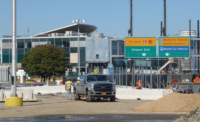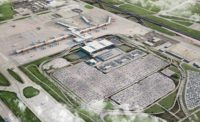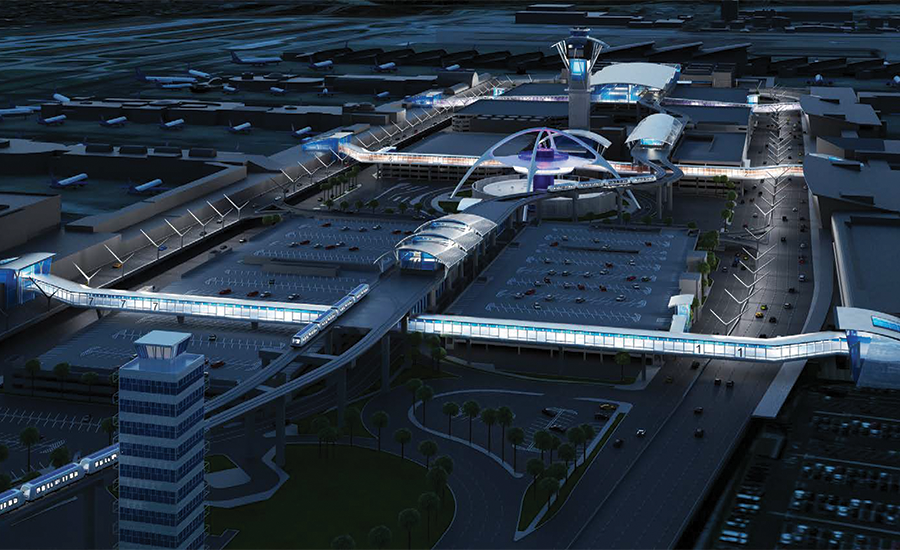Transportation
Smaller Airports Dream Big While LAX Builds Even Bigger

A new midfield concourse will take shape at LAX while Burbank airport officials hope a nearly 30-year fight for a new terminal is over, and San Jose airport gears up for next steps to handle increasing growth.
IMAGE COURTESY OF LAWA

A new midfield concourse will take shape at LAX while Burbank airport officials hope a nearly 30-year fight for a new terminal is over, and San Jose airport gears up for next steps to handle increasing growth.
PHOTO BY AILEEN CHO/ENR

A new midfield concourse will take shape at LAX while Burbank airport officials hope a nearly 30-year fight for a new terminal is over, and San Jose airport gears up for next steps to handle increasing growth.
PHOTO BY AILEEN CHO/ENR



 When Dan Feger joined the Burbank-Glendale-Pasadena Airport Authority 28 years ago, his mission was clear: build a new terminal to replace the one built in 1930. The Federal Aviation Administration said the existing terminal was too close to the runway—just 250 ft. Officials bought land. But the community would have none of it.
When Dan Feger joined the Burbank-Glendale-Pasadena Airport Authority 28 years ago, his mission was clear: build a new terminal to replace the one built in 1930. The Federal Aviation Administration said the existing terminal was too close to the runway—just 250 ft. Officials bought land. But the community would have none of it.
Years of lawsuits, community opposition and political rancor among Burbank, Glendale and Pasadena city officials followed. But now, thanks to new leadership and vigorous outreach, the chances finally look good for the 14-gate, 355,000-sq-ft new terminal, estimated at $400 million, that will meet federal requirements—and catch up with widespread airport trends of better amenities, intermodal connections and security requirements.
“We are finally seeing the light at the end of the tunnel,” says Feger, outgoing executive director and now director of development services. On Aug. 1, the Burbank City Council adopted an ordinance approving a development agreement with the authority, calling for a Nov. 8 special municipal Measure B election to put the matter before Burbank voters. If they approve Measure B, the authority will receive vested rights to build the new passenger terminal and then give Burbank control over it.

|
| Dan Feger |
The existing 14-gate terminal doesn’t meet current seismic standards and isn’t compliant with the Americans with Disabilities Act. There are no jet bridges, for example. The new terminal will include ADA-compliant boarding facilities, a centralized security screening checkpoint, a direct shuttle from the terminal to the airport’s Regional Intermodal Transportation Center (RITC), a lactation room, more family restrooms, and animal relief areas before and after security screening.
“If we win Nov. 8, it’s smooth sailing,” says Feger. “The environmental impact statement won’t be the hard part. The hard part was spending endless hours in the community, rebuilding the loss of trust” from decades past.
That included a $100-million program to soundproof 2,500 homes and extensive public information campaigns about the need for the new terminal. As with users of Kansas City International Airport (ENR 7/25-8/1 p. 6), travelers in Burbank (once called “Bob Hope Airport”) feared losing the convenience of short distances to the gates. “We will preserve the good things while improving what’s needed,” Feger promises. “We’ll double curbside space and have larger hold rooms.”
Like so many airports, especially non-hubs, the Burbank facility took a big hit after 2008, dropping to 2 million from 6 million annual passengers. But last year, it rebounded to 3.9 million. “We want to build as soon as possible,” says Feger. The authority will ponder various delivery methods, potentially including P3, and will engage a project management consultant near the end of the EIS planning.
The Burbank airport was one of two smaller, regional airports ENR visited on the western leg its “Project Runways: America’s Airport Infrastructure” tour.
Silicon Valley Hub
Like Burbank, San Jose International Airport is rebounding from the recession, in which it lost 25% of its flights. Yet, “we were luckier even than other medium-sized hubs,” says airport spokeswoman Vicki Day. In general, at that time, major carriers began to shift a majority of their flights to the big U.S. hubs.
But the San Jose airport has benefitted from its high-tech customers in Silicon Valley. In 2005, the airport launched a $1.3-billion program to build a second terminal and upgrade the first one. The $660-million design-build project, led by Hensel Phelps and Fentress Architects, included a consolidated rental-car facility and the first use of so-called Zenky Air Chairs, which have individual power outlets for charging electronic devices and, from below each seat, pump fresh air directly to passengers. A luxurious day-pass club lounge, a yoga room, high-tech art exhibits and a section devoted entirely to computer use also reflect the Silicon Valley setting.
That still-gleaming new terminal can handle up to 14.4 million annual passengers, but the “trigger”—the right time for the next phase of terminal expansion—is when traffic reaches 12.2 million. This year, the airport is on track for 11 million passengers and will add three new international carriers. “We’re getting there quicker than we thought we would,” says Day. In anticipation of that 12.2-million milestone, airport officials are beginning the preliminary financial planning phase, she adds.
Future consultants, planners and builders will have to contend, however, with the airport’s boxed-in situation: 1,000 acres hemmed in by a river, a freeway, a railroad and an airfield, Day adds. Moreover, a city charter caps the number of gates at 40. “We have 28 gates now.”
Never Lax at LAX
Just two days before ENR visited Los Angeles International Airport (LAX), Mayor Eric Garcetti and Los Angeles World Airports (LAWA) officials announced a tentative memorandum of understanding that would end lengthy litigation with the Alliance for a Regional Solution to Airport Congestion (ARSAC) over LAX modernization plans. LAWA officials hope it will clear the path for billions of dollars in investment in the Landside Access Modernization Program (LAMP).
With 74.9 million annual passengers, LAX is the world’s busiest origin-and-destination airport. Billions of dollars in construction are still underway, despite the 2012 completion of a new $1.3-billion, 1.2-million-sq-ft international terminal, designed by Fentress and built by a Walsh-Austin joint venture; more than $700 million in upgrades to the existing international terminal and a $438-million new central utility plant, both built by a Clark-McCarthy joint venture.
Driving on the airfield, Michael Doucette, LAX chief planner, listed other major terminal construction pieces gearing up or underway: a $508-million terminal renovation by Southwest; a $332-million renovation of Terminal 2, in anticipation of Delta moving in, and $573 million in renovations for two terminals occupied by United.
Delta has even bigger long-term plans for Terminals 2 and 3, which could mean some $1 billion in future work, while other airlines will move into Terminal 5. “We’re touching every terminal,” says Doucette.
On the airfield, some $300 million in runway improvements—particularly to meet federal requirements for 1,000-ft x 500-ft buffer zones at the ends of four runways—are ongoing, while several supersized jets, Airbus A380s, land one after another on a Friday afternoon. As with the Salt Lake City airport (ENR 9 5/12 p. 10), “enabling” work, including relocating hangars and taxiways, also is underway to make room for a future $1.25-billion, 11-gate Midfield Satellite Concourse and related taxiways.
LAWA in 2014 awarded a $961.3-million “progressive design-build” contract to a Turner-PCL joint venture, with designers Corrigan and Gensler. Design is about 60% complete, says Doucette.
But what would be the project headliner at many other airports is just the warm-up act at LAX. The $5.5-billion LAMP program will transform the airport as never before by providing a six-station on-airport people movers (APM) to commuter and light-rail systems built by LA Metro. Two intermodal transportation facilities and a consolidated rental-car center also will be built. In August, five teams responded to a request for qualifications for a design-build-finance-operate maintain contract for the APM, which will have a 2.25-mile-long elevated guideway. Also in August, LA Metro closed the public comment period for the Airport Metro Connector’s 96th Street Transit Station, which it will build below a people-mover station.
Construction on the concourse and terminal are expected to ramp up next year, says Doucette, adding that, with regard to activity, “we’re in a little bit of a valley right now.” But after that, the construction buzz at LAX could last for nearly a decade.







